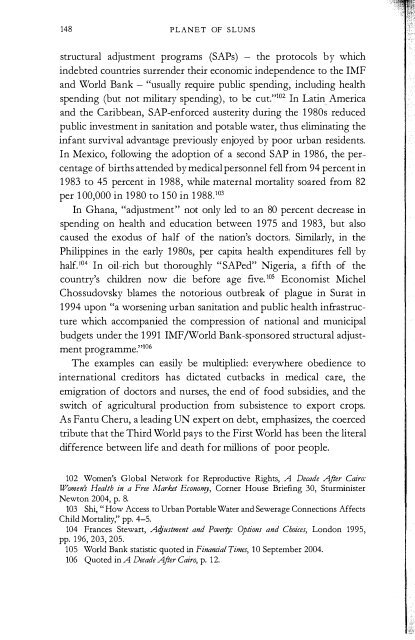Untitled - Rebel Studies Library
Untitled - Rebel Studies Library
Untitled - Rebel Studies Library
You also want an ePaper? Increase the reach of your titles
YUMPU automatically turns print PDFs into web optimized ePapers that Google loves.
148 PLANET OF SLUMS<br />
structural adjustment programs (SAPs) - the protocols by which<br />
indebted countries surrender their economic independence to the IMF<br />
and World Bank - "usually require public spending, including health<br />
spending (but not military spending), to be cut."102 In Latin America<br />
and the Caribbean, SAP-enforced austerity during the 1980s reduced<br />
public investment in sanitation and potable water, thus eliminating the<br />
infant survival advantage previously enjoyed by poor urban residents.<br />
In Mexico, following the adoption of a second SAP in 1986, the percentage<br />
of births attended by medical personnel fell from 94 percent in<br />
1983 to 45 percent in 1988, while maternal mortality soared from 82<br />
per 100,000 in 1980 to 150 in 1988.103<br />
In Ghana, "adjustment" not only led to an 80 percent decrease in<br />
spending on health and education between 1975 and 1983, but also<br />
caused the exodus of half of the nation's doctors. Similarly, in the<br />
Philippines in the early 1980s, per capita health expenditures fell by<br />
half.104 In oil-rich but thoroughly "SAPed" Nigeria, a fifth of the<br />
country's children now die before age five. 105 Economist Michel<br />
Chossudovsky blames the notorious outbreak of plague in Surat in<br />
1994 upon "a worsening urban sanitation and public health infrastructure<br />
which accompanied the compression of national and municipal<br />
budgets under the 1991 IMF/World Bank-sponsored structural adjustment<br />
programme."106<br />
The examples can easily be multiplied: everywhere obedience to<br />
international creditors has dictated cutbacks in medical care, the<br />
emigration of doctors and nurses, the end of food subsidies, and the<br />
switch of agricultural production from subsistence to export crops.<br />
As Fantu Cheru, a leading UN expert on debt, emphasizes, the coerced<br />
tribute that the Third World pays to the First World has been the literal<br />
difference between life and death for millions of poor people.<br />
102 Women's Global Network for Reproductive Rights, A Decade After Cairo:<br />
WomenJ Health in a Free Market Economy, Corner House Briefing 30, Sturminister<br />
Newton 2004, p. S.<br />
103 Shi, " How Access to Urban Portable Water and Sewerage Connections Affects<br />
Child Mortality," pp. 4-5.<br />
104 Frances Stewart, Acfjustment and Poverty: Options and Choices, London 1995,<br />
pp. 196, 203, 205.<br />
105 World Bank statistic quoted in Finanlial Times, 10 September 2004.<br />
106 Quoted in A Decade After Cairo, p. 12.<br />
SLUM ECOLOGY 149<br />
Over 36 million people in the world today are HIV / AIDS infected. Of<br />
these, some 95 percent live in the global south. In particular, sub<br />
Saharan Africa is home to over 25 million people suffering from HIV<br />
and AIDS . ... Each day in Africa more than 5000 people die from<br />
AIDS. Experts estimated that the world community needs to invest US<br />
$7-10 billion every year to fight HIV / AIDS, as well as other diseases<br />
like tuberculosis and malaria. In the face of this humanitarian crisis,<br />
however, African countries continue annually to pay $13.5 billion in debt<br />
service payments to creditor countries and institutions, an amount far in<br />
excess of the United Nations' proposed global HIV / AIDS trust fund.<br />
This massive transfer of resources from poor African countries to<br />
wealthy Northern creditors is one of the factors that has critically<br />
weakened health care and education in the countries that are now worst<br />
affected by the pandemic.107<br />
More recently the World Bank has combined a feminist rhetoric about<br />
the reproductive rights of women and gender equity in medicine with<br />
relentless pressure (in the name of "reform") on aid recipients to open<br />
themselves to global competition from private First World healthcare<br />
providers and pharmaceutical companies. The Bank's 1993 Investing in<br />
Health outlined the new paradigm of market-based health care:<br />
"Limited public expenditure on a narrowly defined package of<br />
services; user fees for public services; and privatized health care and<br />
financing."108 A sterling instance of the new approach was Zimbabwe,<br />
where the introduction of user fees in the early 1990s led to a doubling<br />
of infant mortality.109<br />
But the urban health crisis in the Third World is scarcely the fault of<br />
foreign creditors alone. As urban elites move to gated compounds in<br />
the suburbs, they worry less about the threat of disease in the slums<br />
and more about household security and the construction of high-speed<br />
roads. In India, for example, Susan Chaplin sees sanitation reform<br />
undermined by corrupt officials and an indifferent middle class:<br />
107 Fantu Cheru, "Debt, Adjustment and the Politics of Effective Response to<br />
HIV / AIDS in Africa," Third World QuarterlY, 23:2 (2002), p. 300.<br />
lOS Ibid., p. 9.<br />
109 Deborah Potts and Chris Mutambirwa, "Basics Are Now a Luxury:<br />
Perceptions of Structural Adjustment's Impact on Rural and Urban Areas in<br />
Zimbabwe," Environment and Urbanization 10:1 (April 1995), p. 75.


